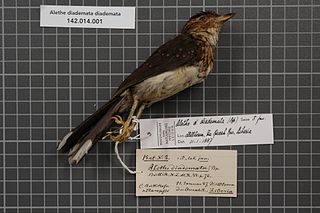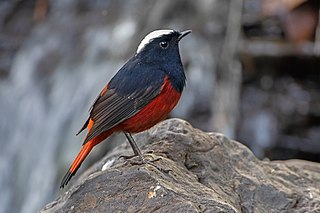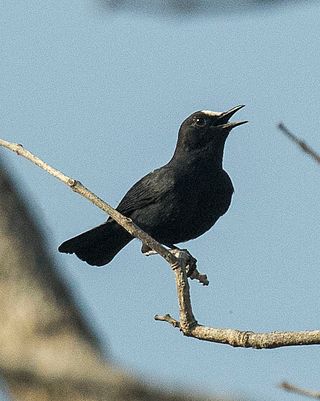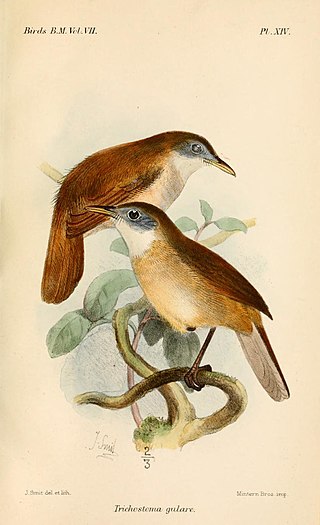
The Ryukyu robin is a bird endemic to the Ryūkyū Islands, of Japan. The Okinawa robin previously was considered a subspecies.

The Old World flycatchers are a large family, the Muscicapidae, of small passerine birds restricted to the Old World, with the exception of several vagrants and two species, bluethroat and northern wheatear, found also in North America. These are mainly small arboreal insectivores, many of which, as the name implies, take their prey on the wing. The family is relatively large and includes 357 species, which are divided into 54 genera.

Alethe is a genus of small mainly insectivorous birds in the Old World flycatcher family Muscicapidae that occur in West Africa.

The whistling thrushes comprise a genus Myophonus of the Old World flycatcher family Muscicapidae.

The cochoas are medium-sized frugivorous, insectivorous and molluscivorous birds in the genus Cochoa. Their bright contrasting plumage patterns, sexual dimorphism and feeding habits made their systematic position difficult to ascertain in early times, Richard Bowdler Sharpe placed them with the Prionopidae in 1879 while many considered them as some kind of aberrant thrush. The genus was previously included in the Old World flycatcher family Muscicapidae but molecular phylogenetic studies have shown that it is more closely related to the thrush family Turdidae.

The Siberian blue robin is a small passerine bird that was formerly classified as a member of the thrush family, Turdidae, but is now more generally considered to belong to the Old World flycatcher family, Muscicapidae. It and similar small European species are often called chats. Recent research suggests that this species and some other East Asian members of Luscinia should be classified in a new genus, together with the Japanese and Ryūkyū robins. The genus name Larvivora comes from the Neo-Latin larva meaning caterpillar and -vorus meaning eating, and cyane is Latin for "dark-blue".

Brachypteryx is a genus of passerine birds in the family Muscicapidae containing ten species known as shortwings, that occurs in southeast Asia.

The mountain chat or mountain wheatear is a small insectivorous passerine bird that is endemic to southwestern Africa.

Melaenornis is a genus of small passerine birds in the large family Muscicapidae commonly known as the Old World flycatchers. They are restricted to sub-Saharan Africa.

The Nilgiri blue robin, also known as Nilgiri shortwing, white-bellied shortwing, Nilgiri sholakili or rufous-bellied shortwing is a species of passerine bird in the family Muscicapidae endemic to the Shola forests of the higher hills of southern India, mainly north of the Palghat Gap. This small bird is found on the forest floor and undergrowth of dense forest patches sheltered in the valleys of montane grassland, a restricted and threatened habitat.

The white-capped redstart or white-capped water redstart is a passerine bird of the Old World flycatcher family Muscicapidae native to the Indian Subcontinent,Southeast Asia, much of China, and to certain regions of Central Asia.

Eumyias is a genus of birds in the Old World flycatcher family Muscicapidae.

The white-bellied redstart is a species of bird of the family Muscicapidae. It is found in Bhutan, China, India, Laos, Myanmar, Nepal, Pakistan, Thailand, and Vietnam, where its natural habitat is temperate forests.

The white-fronted black chat is a species of passerine bird in the family Muscicapidae. It is found in Benin, Burkina Faso, Cameroon, Central African Republic, Chad, Democratic Republic of the Congo, Ivory Coast, Eritrea, Ethiopia, Gambia, Ghana, Guinea, Guinea-Bissau, Mali, Mauritania, Niger, Nigeria, Senegal, Sierra Leone, South Sudan, Togo, and Uganda. Its natural habitats are moist savanna and subtropical or tropical dry shrubland.

Phoenicurus is a genus of passerine birds in the Old World flycatcher family Muscicapidae, native to Europe, Asia and Africa. They are named redstarts from their orange-red tails. They are small insectivores, the males mostly brightly coloured in various combinations of red, blue, white, and black, the females light brown with a red tail. A molecular phylogenetic study published in 2010 led to a reorganization of the Old World flycatchers family in which the two species in Rhyacornis and the single species in Chaimarrornis were merged into Phoenicurus.

Tarsiger is a genus of eight species of birds in the family Muscicapidae. They are small, mostly brightly coloured insectivorous birds native to Asia and northeastern Europe; four of the six species are confined to the Sino-Himalayan mountain system. The genus has sometimes been included within the related genus Luscinia, but the species have been found to form a distinct monophyletic group.

The white-bellied blue robin or white-bellied sholakili, is a bird of the family Muscicapidae. It is endemic to the Shola forests of the higher hills of southern India. The Nilgiri blue robin and this species were once considered separate species, later lumped as sub-species of a single species (major) and elevated again to full species in 2005 by Pamela C. Rasmussen. The species was earlier thought to be related to the shortwings and placed in the genus Brachypteryx and later moved to Myiomela since species in the genus Brachypteryx shows marked sexual dimorphism. In 2017, a study found that this is a sister group of the flycatchers in the genera Niltava, Cyornis and Eumyias among others. It was then placed in newly erected genus Sholicola. This small bird is found on the forest floor and undergrowth of dense forest patches sheltered in the valleys of montane grassland, a restricted and threatened habitat.

Chamaetylas is a genus of small, mainly insectivorous birds in the Old World flycatcher family Muscicapidae that are native to sub-Saharan Africa.

Larvivora is a genus of small passerine birds belonging to the Old World flycatcher family Muscicapidae that occur in central and eastern Asia.

Vauriella is a genus of birds in the Old World flycatcher family Muscicapidae that occur in Borneo and the Philippines.




















